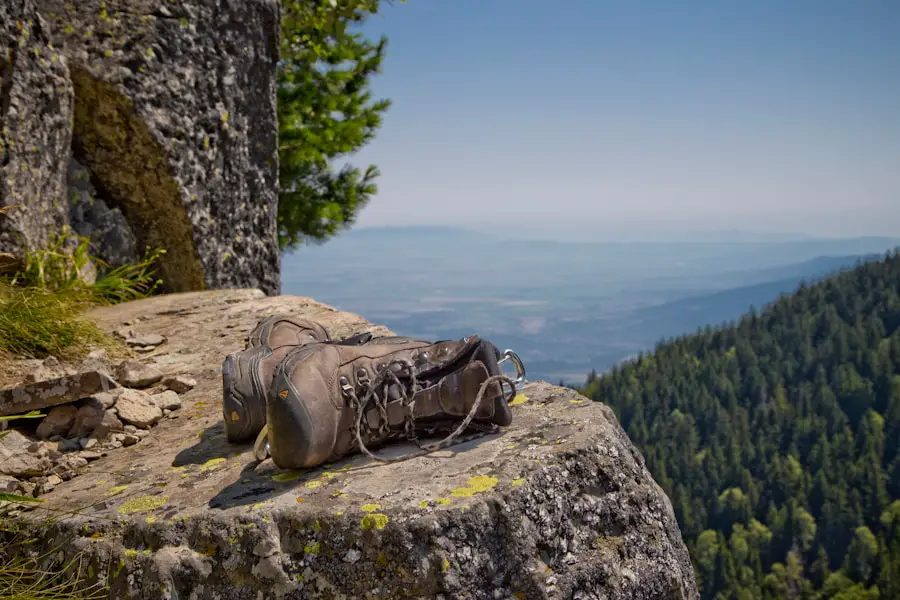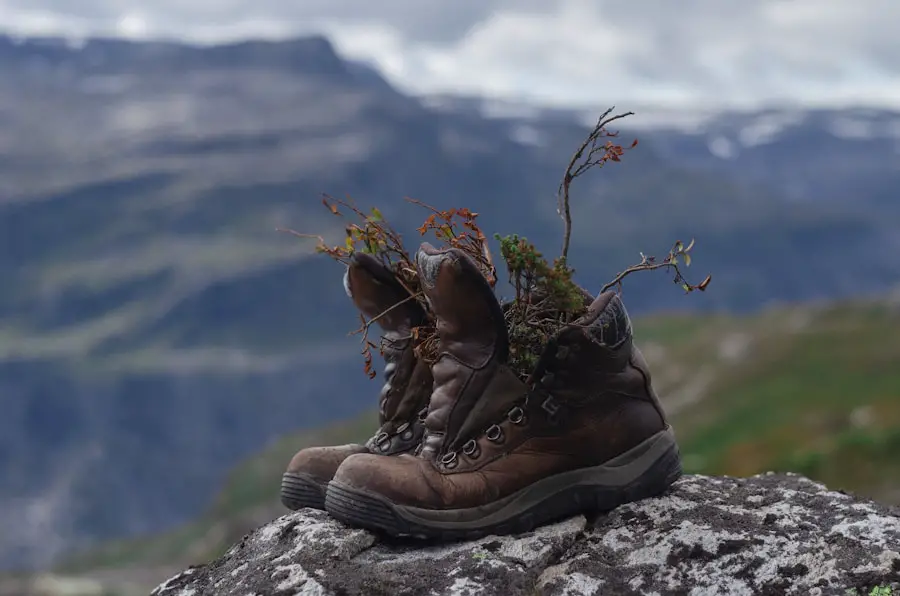Selecting the appropriate size for hiking boots is a critical step that can significantly impact your comfort and performance on the trail. Unlike regular shoes, hiking boots are designed to accommodate various foot shapes and sizes, often requiring a more nuanced approach to sizing. When trying on boots, it is essential to wear the same type of socks you plan to use during your hikes.
This ensures that you get an accurate feel for how the boots will fit in real-world conditions. Many hikers prefer thicker, cushioned socks for added warmth and comfort, especially in colder climates. When assessing fit, pay attention to the toe box.
Your toes should have enough room to wiggle without feeling cramped, particularly when descending hills, where your feet may slide forward. A good rule of thumb is to ensure there is about a thumb’s width of space between your longest toe and the end of the boot. Additionally, consider the width of your foot; some brands offer wide or narrow options to cater to different foot shapes.
It’s also advisable to try on boots later in the day when your feet are slightly swollen from daily activities, as this will give you a more accurate representation of how they will feel during extended wear.
Key Takeaways
- Choose the right size of hiking boots to ensure comfort and prevent blisters and hotspots
- Understand the different types of hiking boots, such as lightweight, midweight, and heavyweight, to match your hiking needs
- Break in your hiking boots gradually to avoid discomfort and blisters on the trail
- Use proper lacing techniques to ensure a secure and comfortable fit while hiking
- Maintain your hiking boots by cleaning, drying, and conditioning them regularly to prolong their lifespan and performance
Understanding Different Types of Hiking Boots
Hiking boots come in various styles, each tailored for specific types of terrain and hiking experiences. Broadly categorized, they can be divided into three main types: lightweight, mid-weight, and heavy-duty boots. Lightweight boots are typically made from synthetic materials and are designed for day hikes or well-maintained trails.
They offer flexibility and breathability, making them ideal for warmer weather or less rugged terrain. However, they may lack the support and durability needed for more challenging hikes. Mid-weight boots strike a balance between support and flexibility, making them suitable for a variety of hiking conditions.
They often feature stiffer midsoles and more robust materials, providing better protection against rocks and uneven surfaces. These boots are versatile enough for both day hikes and multi-day backpacking trips, offering a good compromise between weight and support. Heavy-duty boots, on the other hand, are built for extreme conditions and rugged terrains.
They typically feature a high ankle design for added support and are made from durable leather or synthetic materials that can withstand harsh weather and rough trails. These boots are ideal for serious backpackers or those who frequently hike in mountainous regions.
Breaking in Your Hiking Boots

Once you have selected the right pair of hiking boots, the next crucial step is breaking them in properly. New boots can be stiff and may cause discomfort if worn for extended periods without prior acclimatization. The breaking-in process allows the materials to soften and conform to the unique shape of your feet, reducing the risk of blisters and hotspots during your hikes.
A common recommendation is to wear your new boots around the house or during short walks before embarking on longer treks. This gradual exposure helps identify any pressure points or areas that may need adjustment. During the breaking-in phase, it’s beneficial to wear the same socks you plan to use on your hikes.
This not only helps with fit but also allows you to gauge how the boots perform with your chosen sock material. Start with short walks of about 30 minutes to an hour, gradually increasing the duration as your feet become accustomed to the new footwear. Pay attention to how your feet feel during these initial outings; if you notice any discomfort or pinching, consider adjusting the lacing or trying different socks.
The goal is to ensure that by the time you hit the trail for a longer hike, your boots feel like a natural extension of your feet.
Proper Lacing Techniques
| Lacing Technique | Benefits | Drawbacks |
|---|---|---|
| Criss-Cross Lacing | Even pressure distribution, comfortable fit | May loosen over time |
| Straight Bar Lacing | Prevents slippage, adds stability | Difficult to adjust tension |
| Loop Back Lacing | Customizable fit, reduces pressure points | Time-consuming to lace |
Lacing techniques play a significant role in achieving a secure fit and enhancing comfort while hiking. The way you lace your boots can affect how they feel on your feet, particularly during long treks where fatigue can set in. A common method is the standard crisscross lacing, which provides a balanced fit across the instep.
However, there are variations that can help address specific issues such as heel slippage or pressure points. For those experiencing heel lift, a technique known as “heel lock” lacing can be particularly effective. This involves creating a loop with the laces at the top eyelets before threading them through the next set of eyelets down.
This method pulls the heel back into the boot, reducing movement and enhancing stability on uneven terrain. Additionally, if you have high arches or experience pressure on certain areas of your foot, consider using skip lacing techniques where you skip one or more eyelets in specific sections to relieve pressure while still maintaining a snug fit.
Maintaining Your Hiking Boots
Proper maintenance of hiking boots is essential for prolonging their lifespan and ensuring optimal performance on the trail. Regular cleaning is one of the most important aspects of boot care. After each hike, especially in muddy or wet conditions, it’s crucial to remove dirt and debris from both the exterior and interior of the boots.
Use a soft brush or cloth to wipe away mud and grime, paying special attention to seams and crevices where dirt can accumulate. For leather boots, applying a specialized cleaner can help maintain their suppleness and prevent cracking. In addition to cleaning, conditioning leather boots with a suitable leather conditioner can help preserve their integrity over time.
Conditioning prevents leather from drying out and cracking while also enhancing water resistance. For synthetic materials, check if there are specific care instructions provided by the manufacturer; some may require different cleaning agents or methods. Furthermore, storing your boots properly is vital; avoid leaving them in damp areas or direct sunlight, as this can lead to mold growth or material degradation.
Instead, store them in a cool, dry place with adequate ventilation.
Dealing with Hotspots and Blisters

Hotspots and blisters are common issues faced by hikers, often resulting from friction between the boot and foot during movement. Identifying hotspots early is crucial; these are areas where you begin to feel discomfort before a blister forms. To mitigate this risk, consider using blister prevention products such as moleskin or blister pads that can be applied directly to areas prone to friction.
These products create a protective barrier that reduces rubbing against the skin. Another effective strategy is to ensure that your socks fit well and are made from moisture-wicking materials that help keep your feet dry. Wet feet are more susceptible to blisters due to increased friction; therefore, choosing socks designed specifically for hiking can make a significant difference.
If you do develop blisters despite preventive measures, it’s essential to treat them properly to avoid infection. Clean the area gently with soap and water, then cover it with a sterile bandage or blister pad to protect it while it heals.
Waterproofing and Weatherproofing
Weather conditions can vary dramatically while hiking, making waterproofing an essential consideration when selecting hiking boots. Many manufacturers offer waterproof models that incorporate technologies such as Gore-Tex or other breathable membranes designed to keep water out while allowing moisture from sweat to escape. However, even waterproof boots require additional care to maintain their effectiveness over time.
Regularly applying a waterproofing treatment can enhance your boots’ resistance to water penetration. There are various products available, including sprays and waxes specifically formulated for different materials such as leather or synthetic fabrics. Before applying any treatment, ensure that your boots are clean and dry; this allows the product to adhere properly and create an effective barrier against moisture.
Additionally, consider weatherproofing your boots based on the conditions you expect to encounter on your hikes; for instance, if you anticipate wet conditions frequently, investing in high-quality waterproofing treatments will be beneficial.
Knowing When to Replace Your Hiking Boots
Recognizing when it’s time to replace your hiking boots is crucial for maintaining safety and comfort on the trail. Over time, even high-quality boots will show signs of wear that can compromise their performance. One of the most obvious indicators is visible damage such as cracks in the leather or separation at seams; these issues can lead to water infiltration and reduced support during hikes.
Another sign that it may be time for new boots is decreased traction on various surfaces due to worn-out soles. If you find yourself slipping more often than before or if the tread pattern has become smooth rather than textured, it’s likely time for a replacement. Additionally, if you experience persistent discomfort or pain during hikes despite proper fitting and maintenance practices, this could indicate that your boots no longer provide adequate support for your feet.
Regularly assessing your footwear will help ensure that you remain comfortable and safe while enjoying your outdoor adventures.
If you’re looking for the perfect hiking boots for your next adventure, you may also be interested in this article on 5 Must-Have Minimalist Travel Backpacks for Spring Adventures. Just like finding the right pair of boots is essential for a successful hike, having the right backpack can make all the difference in your travel experience.
FAQs
What are the important factors to consider when fitting hiking boots?
When fitting hiking boots, it’s important to consider the size, width, and shape of your feet, as well as the type of hiking you’ll be doing and the terrain you’ll be covering.
How should hiking boots fit?
Hiking boots should fit snugly but not too tight, with enough room in the toe box to wiggle your toes. Your heel should not lift up when walking, and there should be no pressure points or areas of discomfort.
Should I wear hiking socks when trying on hiking boots?
Yes, it’s important to wear the same type of socks you’ll be wearing on the trail when trying on hiking boots. This will ensure a more accurate fit.
When is the best time to try on hiking boots?
The best time to try on hiking boots is in the afternoon or evening, as your feet tend to swell throughout the day. This will give you a better idea of how the boots will fit during a hike.
What should I look for in terms of ankle support when fitting hiking boots?
When fitting hiking boots, look for ankle support that is snug but not restrictive. The boots should provide enough support to prevent ankle rolling, especially on uneven terrain.
How do I break in new hiking boots?
To break in new hiking boots, wear them around the house or on short walks before hitting the trails. This will help the boots mold to your feet and prevent blisters and discomfort.
